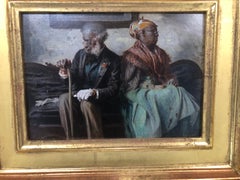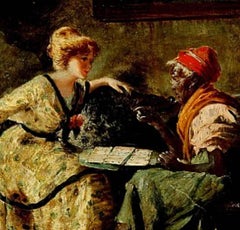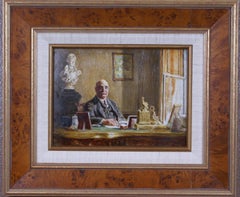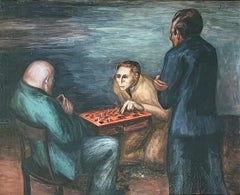Harry Herman Roseland Paintings
to
1
1
Overall Width
to
Overall Height
to
2
1
2
2
2
2
1
2
2
2
784
713
707
707
2
2
Artist: Harry Herman Roseland
Harry Roseland “Silent Treatment”
By Harry Herman Roseland
Located in San Francisco, CA
Harry Roseland: 1866-1950. Well listed American artist with auction results over $250,000. This fabulous incredibly detailed oil on board measures 11 inches wide by 8 inches high. Th...
Category
Early 20th Century American Realist Harry Herman Roseland Paintings
Materials
Oil
Prophecy
By Harry Herman Roseland
Located in Fort Washington, PA
Tarot card reading
Category
1920s Harry Herman Roseland Paintings
Materials
Oil
Related Items
J.P. Morgan
Located in Storrs, CT
A 20th-century American School oil painting on board featuring American banker and financier J.P. Morgan (1837-1913) seated at his desk. Light streams throug...
Category
Mid-20th Century American Realist Harry Herman Roseland Paintings
Materials
Oil
Chess Players WPA Depression Era Mid-20th Century American Scene Realism Modern
By Mervin Jules
Located in New York, NY
Chess Players WPA Depression Era Mid-20th Century American Scene Realism Modern. Signed upper right and verso 8 x 10 inches oil on board.
BIO
The son of a men's haberdasher, Mervin ...
Category
1930s American Realist Harry Herman Roseland Paintings
Materials
Oil, Board
$6,800
H 10 in W 12 in D 2 in
Street of the Old Quarter British School signed Cade oil on canvas painting
Located in Barcelona, Barcelona
**Technical Sheet**
**Title:** "Street of the Old Quarter"
**Author:** British School, 19th Century
**Date:** 1892
**Technique:** Oil on canvas
**Dimensions:** 14.17 x 10.63 inc...
Category
1890s American Realist Harry Herman Roseland Paintings
Materials
Canvas, Oil
$830 Sale Price
41% Off
H 14.18 in W 10.63 in
American School Portrait of a Child
Located in Astoria, NY
American School, Portrait of a Child with Red Tulip Flower, Oil on Canvas, circa 1900, illegibly signed "J. Hisnik(?)" and inscribed "N.Y." lower left, ebonized giltwood frame. Image...
Category
Late 19th Century American Realist Harry Herman Roseland Paintings
Materials
Canvas, Oil
Antique American Impressionist Birch Tree Landscape in a Reflecting Pond 1940
Located in Douglas Manor, NY
6000 Antique birch trees landscape,oil on artist board displayed in a wood frame.Signed lower left by Mori.Image size 9.5 H x 7.5 W
Category
1940s Harry Herman Roseland Paintings
Materials
Oil
$475
H 13 in W 11 in D 1 in
1880s Figurative Sackett's Calvary Charge of the 9th New York Volunteers
Located in Soquel, CA
Late 19th century figurative painting of the battle of Trevilians Station and of the wounding of Colonel Sackett June 11, 1864. Oil on canvas in giltwood frame. Signed or notated ind...
Category
1880s American Realist Harry Herman Roseland Paintings
Materials
Linen, Oil, Stretcher Bars
$3,850 Sale Price
30% Off
H 25.75 in W 41.75 in D 1.25 in
Doctor's Office. Mid-Century American Scene Oil Painting Youngstown, OH.
Located in Marco Island, FL
An anxious moment waiting to see the doctor is depicted by Clyde Singer in this quiet and still painting. Entitled Doctor's Office (1949), Singer paints a moment of anticipation and...
Category
1940s American Realist Harry Herman Roseland Paintings
Materials
Panel, Oil
Vintage Sailboat Under Full Sails in Open Waters
Located in Douglas Manor, NY
5193 American Modernist Sailboat at Full Mast Inscribed on back
Proud Little Coaster John Chancelor"
Gilt frame Image size 16.5x23"
Signed Ranrd 1996
Category
1990s Harry Herman Roseland Paintings
Materials
Oil
Vintage Montmartre Paris Impressionist Oil Landscape 1950's
Located in Douglas Manor, NY
6011 Oil on canvas the streets of Paris set in a vintage wood frame
Image size 9.5x8"
Category
1950s Harry Herman Roseland Paintings
Materials
Oil
"Sunday Gardening" Colorful Impressionistic Floral Oil Painting Framed
Located in New York, NY
This piece is a pertinent example of George Holloway's most sought after works, depicting a Garden view with flowers by sunlit homes. As an American Impressionist artist, most of Ho...
Category
Early 20th Century Impressionist Harry Herman Roseland Paintings
Materials
Oil, Canvas
$1,200
H 26.5 in W 31 in D 2.5 in
"Little Discoveries" Mother and Daughter at Paris Museum with Monet Oil Painting
By Cindy Shaoul
Located in New York, NY
A lively, impressionistic depiction of a Mother and Daughter discovering a monumental Claude Monet painting at the Paris Museum. We are whisked away in this cherished scene with the ...
Category
2010s American Impressionist Harry Herman Roseland Paintings
Materials
Canvas, Oil
$1,800
H 25.5 in W 19.5 in D 1.5 in
Stanley Bielen "Flower Fiesta" - Oil on Paper/Mounted
By Stanley Bielen
Located in New York, NY
Stanley Bielen’s paintings often begin with him planting the flower that he intends to capture in paint. He brings clippings from his garden into the studio and combines his intensit...
Category
2010s Abstract Impressionist Harry Herman Roseland Paintings
Materials
Paper, Oil
Previously Available Items
"Beauty with Red Roses"
By Harry Herman Roseland
Located in Southampton, NY
Oil on canvas painting by the well known American artist, Harry Roseland. Signed lower left and dated 1919. The painting depicts a beautiful young lady wearing a pearl necklace and with red roses in her hair and on her dress. Unlined. Craquelure throughout, minor stretcher bar wear. In paint in face, roses, neckline and background areas. Unframed.
Harry Roseland was born in 1866 to German immigrants in Brooklyn, New York, where he lived his entire life. Roseland studied art under John Bernard...
Category
1910s Academic Harry Herman Roseland Paintings
Materials
Canvas, Oil
Harry Herman Roseland 1866 1950 American paintings for sale on 1stDibs.
Find a wide variety of authentic Harry Herman Roseland 1866 1950 American paintings available for sale on 1stDibs. Customers who are interested in this artist might also find the work of Terri Dilling, Abraham Pariente, and Doris Warner.



